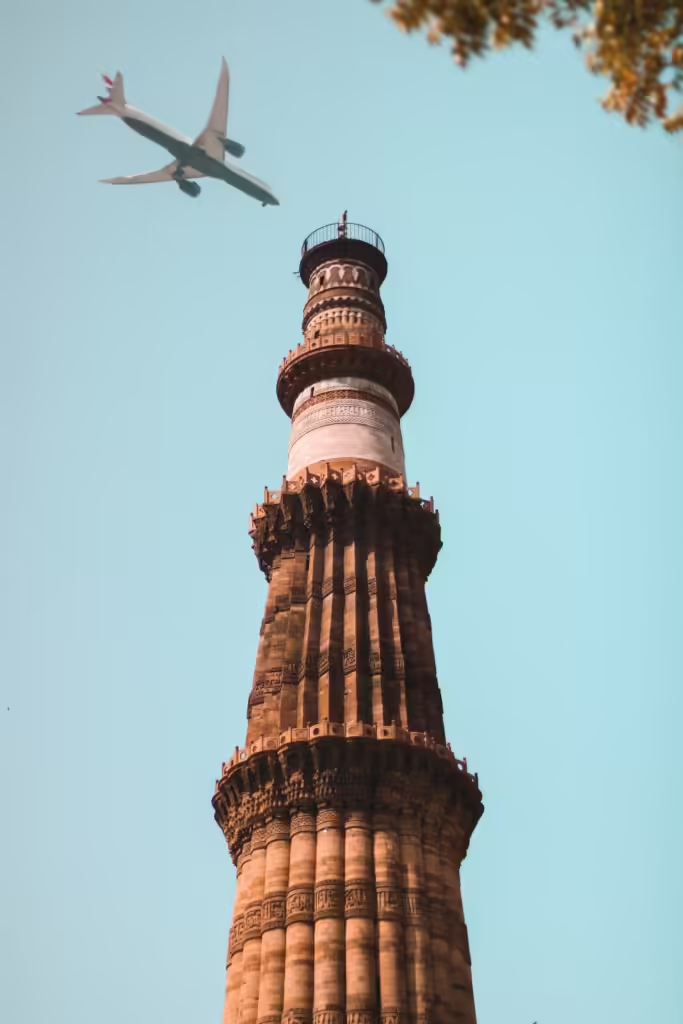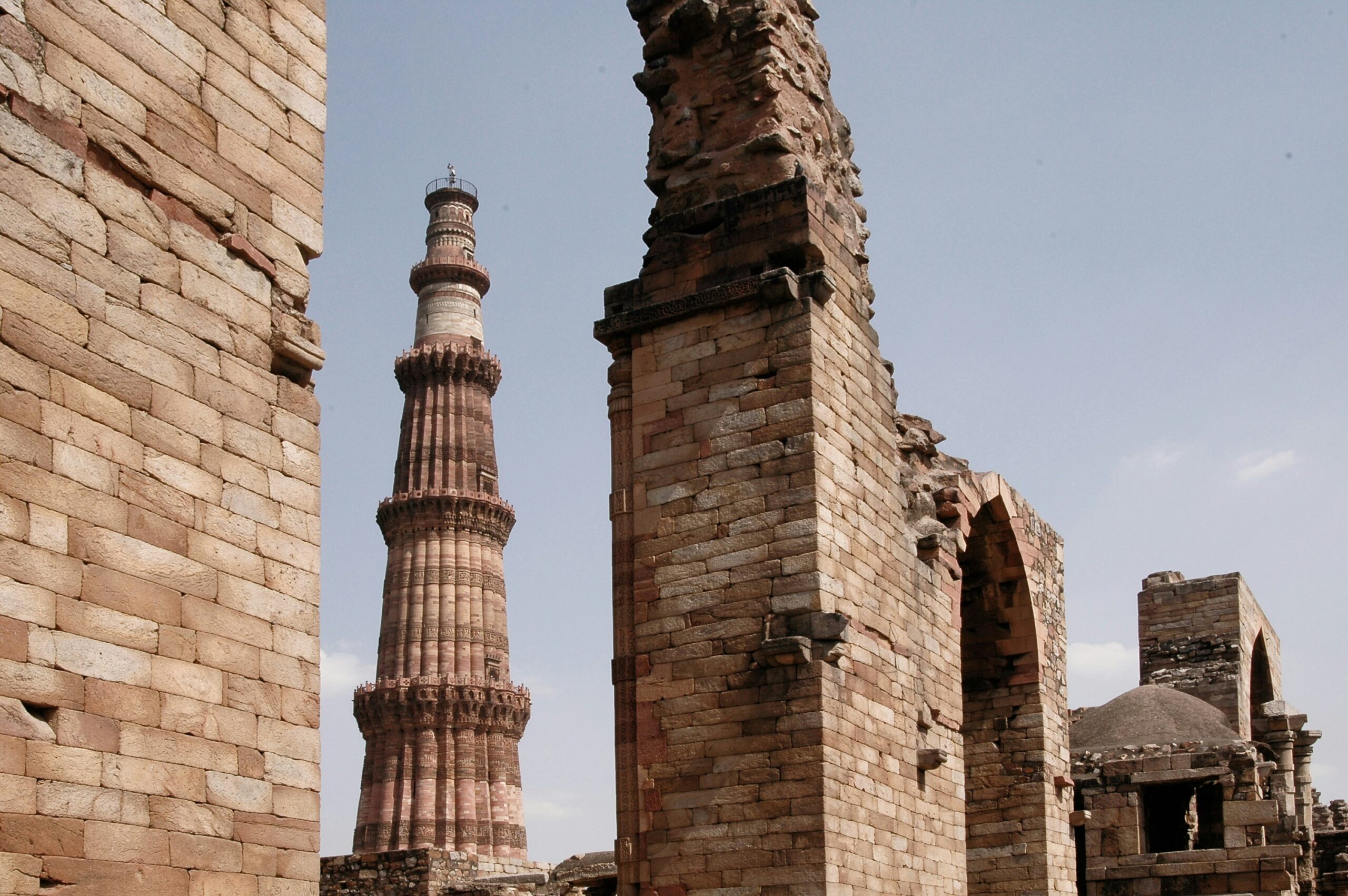Your Essential Guide to Exploring Delhi’s Magnificent Qutub Minar
It encapsulates the blog’s purpose of providing comprehensive information and tips for visitors. It focuses on highlighting the historical and architectural significance of Qutub Minar, one of Delhi’s most iconic monuments. The guide aims to offer practical advice on optimal visiting times, noteworthy features to explore, historical context, and nearby attractions. It serves as a go-to resource for travelers seeking to fully appreciate the splendor and cultural importance of this UNESCO World Heritage site in Delhi. It also aims to enrich the visitor’s experience by providing insights into the cultural and artistic heritage preserved within the Qutub Complex, making it an essential destination for history enthusiasts and casual travelers alike.
History of Qutub Minar:

Qutub Minar, standing tall, is a monumental symbol of India’s dynamic historical past and proudly sits in the heart of Delhi Soaring high. This history portrays the country’s cultural legacy. Qutub Minar was built in 1192 by a person named Qutub-ud-din Aibak, and he is considered to be the founder of the Delhi Sultanate. The giant structure was intended to commemorate Aibak’s triumph over the last Hindu kingdom in Delhi. Rulers over the years like Iltutmish and Firoz Shah Tughlaq further developed and refined the monument.
Qutub Minar is far more than just an architectural wonder; it reflects the history of those changing socio-political conditions in medieval India. It has intricate stone carvings of Quranic verses inscribed on sandstone, which adds a religious bent to its historical significance. Importantly, the Iron Pillar from the Qutub complex is still a wonder and shows the metallurgy proficiency of ancient India.
Throughout testing times of history in Delhi, Qutub Minar stands amid the birth and decay of empires. Its Indo-Islamic style of architecture that speaks the language of intricate detailing narrating stories about past times. Today when a visitor wandering around the Qutub Minar does not only see this majestic monument but faces lots of events that had an impact on India’s history.
How to Reach Qutub Minar:
By Air: Indira Gandhi International Airport in Delhi is the nearest airport to Qutub Minar, offering good connections with major cities across India. Taxis and auto rickshaws are readily available at the airport. The approximate cost for a taxi to Qutub Minar complex ranges from ₹400 to ₹600 (approximately $5 to $8 USD), depending on the distance and traffic conditions.
By Train: Delhi has an extensive railway network connecting it to various parts of India. From any of the railway stations in Delhi, such as New Delhi Railway Station or Old Delhi Railway Station, you can easily reach Qutub Minar by local vehicles like taxis or auto-rickshaws. The cost for a taxi or auto-rickshaw ride from central Delhi to Qutub Minar typically ranges from ₹200 to ₹300 (approximately $3 to $4 USD).
By Road: Delhi’s well-maintained road network ensures a smooth journey to Qutub Minar from various cities. State-run buses and private cabs provide comfortable transportation options. The cost for a bus ride to Qutub Minar varies based on the starting point but generally ranges from ₹50 to ₹200 (approximately $0.70 to $3 USD), depending on the type of bus and distance. Exploring the Qutub Minar complex with local transport options like cycle-rickshaws or by hiring bicycles offers a budget-friendly and immersive experience, with rental costs starting from ₹50 per hour (approximately $0.70 USD).
Must-See Attractions :
Qutub Minar: The towering masterpiece itself, Qutub Minar, standing at 73 meters, is an absolute must-see. Marvel at the intricate carvings and the architectural grandeur that has withstood the test of time.
Quwwat-ul-Islam Mosque: Explore the Quwwat-ul-Islam Mosque, the first mosque built in Delhi. Admire the stunning architecture, including the iconic Iron Pillar, known for its rust-resistant composition.
Alai Darwaza: Witness the imposing Alai Darwaza, an impressive gateway to the Qutub Complex. The detailed craftsmanship and unique architectural elements make it a captivating sight.
Iron Pillar: Visit the Iron Pillar, an ancient metallurgical marvel from the 4th century. The pillar, known for its corrosion resistance, stands as a testament to the advanced engineering of its time.
Tomb of Iltutmish: Pay homage to the Tomb of Iltutmish, the second ruler of the Delhi Sultanate. The intricately decorated tomb is an architectural gem within the Qutub Complex.
Ala-ud-din Khilji’s Tomb and Madrasa: Explore the tomb and madrasa complex built by Ala-ud-din Khilji. The structures showcase Indo-Islamic architecture and offer a glimpse into the historical context of their construction.
Activities at Qutub Minar:
- Climb the Qutub Minar: Ascend the spiral staircase of the Qutub Minar for a breathtaking panoramic view of Delhi’s skyline. The climb is a thrilling experience, offering unique perspectives of the city.
- Photography and Sightseeing: Capture the awe-inspiring architecture and historical grandeur of Qutub Minar. The complex provides numerous picturesque spots for photography, making it a paradise for shutterbugs.
- Interactive Guided Tours: Engage in guided tours provided by experts. Gain insights into the historical significance, architectural nuances, and intriguing stories behind each structure within the Qutub Complex.
- Picnicking and Relaxation: Enjoy a leisurely day by packing a picnic and relaxing in the lush green surroundings of the Qutub Complex. The serene ambiance makes it an ideal spot for unwinding amid historical marvels.
- Shopping at Qutub Complex: Explore the vibrant market near Qutub Minar, known for its handicrafts, traditional artifacts, and unique souvenirs. It’s an excellent opportunity to indulge in some local shopping.
- Attend Cultural Events: Check for any cultural events or performances taking place at the Qutub Complex. The venue occasionally hosts concerts, art exhibitions, and other cultural festivities.
Pro Tips:
- Unique Perspective from the Iron Pillar: Gain a unique view of Qutub Minar from the 13th-century Iron Pillar located in the complex. Known for its rust-resistant composition and intricate inscriptions, this pillar offers a fascinating historical backdrop against the towering minaret.
- Capture Intricate Carvings: Equip yourself with a zoom lens to capture the intricate details of the carvings high up on Qutub Minar. These ancient designs and calligraphy showcase the artistic mastery of medieval craftsmen and provide a closer look at the minaret’s architectural splendor.
- Artisan Souvenirs at Craft Shops: Explore the row of craft shops lining the entrance to Qutub Minar, offering artisan souvenirs like handcrafted marble tabletops, intricate metalwork, and traditional textiles. These unique mementos are perfect for commemorating your visit and supporting local craftsmanship.
- Lively Ambience at Alai Darwaza: Immerse yourself in the lively ambiance of the adjacent 14th-century ruin, Alai Darwaza. Marvel at its grand domed ceilings and intricate Islamic architectural features, reflecting the glory of Delhi’s medieval history and craftsmanship.
- Visit Zafar Mahal: Extend your exploration to the nearby 18th-century Delhi summer palace, Zafar Mahal. Known for its Mughal-inspired architecture and serene surroundings, this palace offers a peaceful retreat after exploring the main complex of Qutub Minar.
- Engage with History and Culture: Engage with the rich history and cultural heritage of Qutub Minar through guided tours, informative exhibits at the Archaeological Museum, and cultural performances held within the complex. These experiences provide deeper insights into Delhi’s architectural evolution and cultural diversity over the centuries.
- Relax and Reflect: Take moments to relax and reflect amidst the tranquil gardens and historical ruins surrounding Qutub Minar. Whether enjoying a picnic or simply soaking in the serene atmosphere, these spaces offer a peaceful retreat from the bustling city life of Delhi.
Conclusion:
Qutub Minar stands as a timeless testament to Delhi’s rich history and architectural prowess. As you explore its towering minaret, ancient ruins, and intricate carvings, you embark on a journey through centuries of cultural heritage. From practical tips on optimal visiting times and must-see features to insights into nearby attractions and transportation options, this guide equips you to make the most of your visit. Whether you’re captivated by its historical significance, mesmerized by its artistic beauty, or simply seeking a serene escape amidst bustling Delhi, Qutub Minar promises an unforgettable experience that resonates long after you’ve left its majestic splendor.
Share Your Experience:
A trip to the Qutub Minar is like retracing Delhi’s magnificent Islamic past. This is one of the UNESCO gems that has fascinated travelers for centuries with its stunning architectural monuments. The minaret and its neighboring ruins and gardens, from its amazing scale to the details of carvings deliver extraordinary information about the capital’s bygone days. As you are lost in the magical details of your Delhi destination, remember to record your own experience at this historic site with Xplro! Put your stories and best memories in the comments to encourage other travelers.
Explore More
Delve into the intricate history of Qutub Minar with our expert tips. Ascend the towering minaret for breathtaking views, capture detailed carvings with a zoom lens, and browse artisanal souvenirs at the craft shops. Immerse yourself in the ambiance of nearby Alai Darwaza and visit the serene Zafar Mahal. Uncover hidden gems and enrich your visit with cultural insights for an unforgettable experience at this UNESCO World Heritage site. for more such relatable blogs you can search our website. Share your experiences to us to Xplro.
Happy and safe travels!






